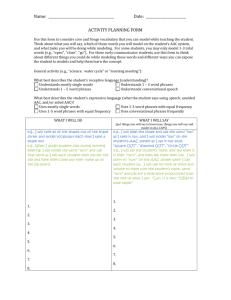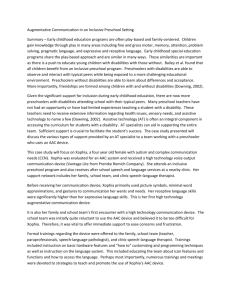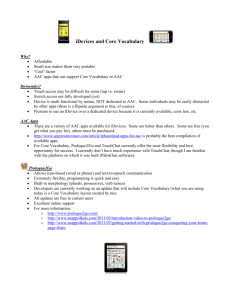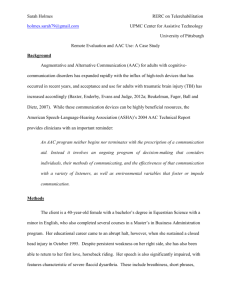In this country we are justly proud of the freedom of speech, that we
advertisement
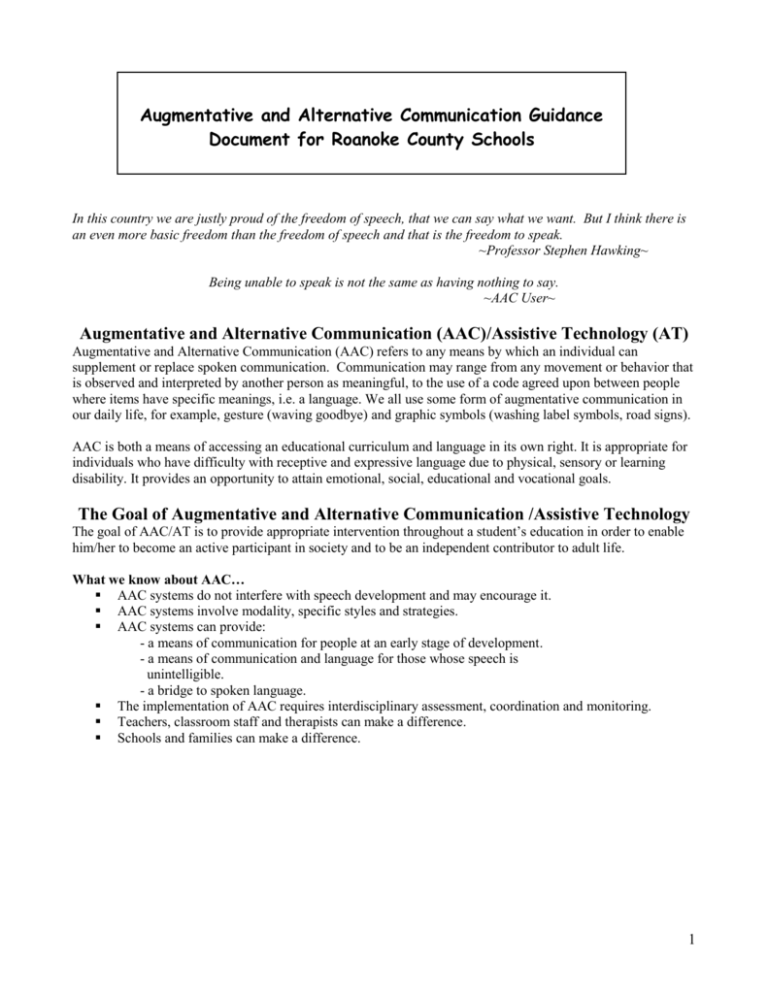
Augmentative and Alternative Communication Guidance Document for Roanoke County Schools In this country we are justly proud of the freedom of speech, that we can say what we want. But I think there is an even more basic freedom than the freedom of speech and that is the freedom to speak. ~Professor Stephen Hawking~ Being unable to speak is not the same as having nothing to say. ~AAC User~ Augmentative and Alternative Communication (AAC)/Assistive Technology (AT) Augmentative and Alternative Communication (AAC) refers to any means by which an individual can supplement or replace spoken communication. Communication may range from any movement or behavior that is observed and interpreted by another person as meaningful, to the use of a code agreed upon between people where items have specific meanings, i.e. a language. We all use some form of augmentative communication in our daily life, for example, gesture (waving goodbye) and graphic symbols (washing label symbols, road signs). AAC is both a means of accessing an educational curriculum and language in its own right. It is appropriate for individuals who have difficulty with receptive and expressive language due to physical, sensory or learning disability. It provides an opportunity to attain emotional, social, educational and vocational goals. The Goal of Augmentative and Alternative Communication /Assistive Technology The goal of AAC/AT is to provide appropriate intervention throughout a student’s education in order to enable him/her to become an active participant in society and to be an independent contributor to adult life. What we know about AAC… AAC systems do not interfere with speech development and may encourage it. AAC systems involve modality, specific styles and strategies. AAC systems can provide: - a means of communication for people at an early stage of development. - a means of communication and language for those whose speech is unintelligible. - a bridge to spoken language. The implementation of AAC requires interdisciplinary assessment, coordination and monitoring. Teachers, classroom staff and therapists can make a difference. Schools and families can make a difference. 1 Suggested Responsibilities for Those Involved with AAC/AT… The Case Manager: Contact Region Coordinator to discuss AT needs for individual students. Review progress and/or barriers at least annually at the IEP meeting. Teachers (General or Special Education): Keep data as to progress or lack of progress. Facilitate opportunities for both social and educational communication within the classroom setting. Provide students with choices and chances to be active in their own learning. Do not let the student fall into the role of passive receiver. Incorporate symbols into all areas of the curriculum and not just AAC sessions. Symbols and schedules should be displayed so they’re easily visible and accessible to users and instructors. Promote balance between curricular and social skills. Speech Language Pathologist: Monitor progress regularly. Ensure that communication boards or devices are changed regularly. Oversee the development of a successful communication environment. Utilize a variety of modes for communication: AAC users will often need to be to be taught to use more than one mode of communication according to their individual needs and abilities. There is a misunderstanding about low (e.g. communication chart) and high tech systems (often computer based with voice out-put). Students often need both depending on their environment. Emphasize the importance of communicative intent: Provide students with choices and chances to be active in their own learning. Promote balance between curricular and social skills. Review progress and barriers at least annually. Occupational and Physical Therapists: Assist with choice and support of access method Provide resources including seating, positioning, and access devices Evaluate, as requested, and advise how sensory issues may influence communication and use of an AAC device Help identify barriers and supports. How to Obtain a Consult or Equipment: 1.) Complete the AT Consideration Form and pony or fax to your Region Coordinator if the IEP team feels AT is warranted. The Region Coordinator will assist the team in finding AT resources available. Schools and other providers will be expected to show clear evidence of the resources used and trialled, as well as reports of reviews, target settings and outcomes. If a T/TAC consultation is being considered, please contact Susie Mikels at 562-3900 prior to making the referral. 2.) If a student is assigned AT and this needs to go back and forth from home to school, the case manager should complete the Assistive Technology Checkout Form and submit a copy to Lorrie Wilson. 3.) If you know the exact device or equipment you need, case managers should complete the Assistive Technology Request Form and fax to the appropriate Region Coordinator. The Region Coordinator will determine if we have the item available in our AT library. If the item is available, it will be delivered to your school from central office. If you need something that isn’t available, your Region Coordinator can assist with the purchasing process. 4.) For students using AT during the summer or transferring schools within the county, the case manager must complete the Equipment Transfer Form. 2 5.) If a piece of equipment needs to be repaired, the case manager should contact the appropriate Region Coordinator PRIOR TO returning the equipment. Funding for AT A Special Education Region Coordinator should be involved with any meeting that deals with funding or purchasing. If the Region Coordinator is not involved, individual schools will incur the cost of the equipment/materials placed into the IEP. Currently the low tech augmentative communication boards and simple speech output devices are provided by the school system. For high tech augmentative communications devices, the funding process goes in the following order: 1.) 2.) 3.) 4.) Parent’s private insurance is billed for the AT Medicaid pays for the AT The Birth Injury Fund pays for the AT Roanoke County Public Schools pays either what is not covered by above agencies if they are available to a student or pays the entire bill if none of the above are available. No device will be considered until the student has had a trial period with it of at least a month and sometimes more if needed. Both Roanoke County Schools and the Training and Technical Assistance Center (T/TAC) at Virginia Tech have some devices that can be used for trial periods. Awareness Training & Training for Specific Equipment Roanoke County Schools will provide training, support, access to and maintenance of the equipment used with specific students. In addition, awareness training should be part of the induction process for all new staff. If you have specific training needs, please contact the Region Coordinator. Professional Development Opportunities Roanoke County Schools provides funding for certain professional development activities related to AAC and AT. This can include being released from regular responsibilities to attend training, attending local and national conferences as well as support from outside agencies. All requests for professional development activities should be routed through the appropriate Special Education Region Coordinator. 3 AAC and the Individual Education Plan (IEP) Specific names of devices should not be listed or included in the goals and objectives or on the accommodations page of the IEP. Instead of saying “The student will use the Pathfinder to . . .” you should state, “The student will use a voice output communication aid to . . . “ or “The student will use an augmentative communication device to . . .” Specific names of devices should be used in the PLOP to describe what the student does and how he/she accesses the device. The IEP committee decides what assistive technology the student will use and what will be transported between home and school. If the student uses a device at home, a parent/guardian needs to sign the Assistive Technology Checkout Form concerning responsibility. Helpful Tips for AAC/AT WAIT – the AAC user takes longer than natural speakers to initiate a communication attempt - this is probably the most important thing we can do. Be aware that the AAC user may be using a wide range of different communication modalities. Look for the user’s non-verbal clues, especially gesture. Make sure that the user has all the necessary vocabulary in his/her AAC system that he/she knows where this vocabulary is stored/displayed and that he/she knows how to use it. Make time to have informal chats without a fixed agenda. Don’t always stick to safe topics. Ask questions about something you genuinely don’t know about. Try to explore one topic fully before moving on to another – don’t flit from one idea to the next. Check with the user that you have understood – don’t assume that you have, and never pretend that you have. If a misunderstanding is occurring, give possible interpretations of what the user is trying to say rather than definitive ones. Using a communication aid is slow. Initially the user may only be able to use one or two words. As unaided speakers we use 150-200 words per minute. The equivalent for an aided speaker is between 5 and 20 words. This has obvious implications for developing equality of opportunity in communication particularly in settings where students are educated in groups of mixed ability levels or in integrated settings. Encourage use of the communication aid at all times with friends, relatives etc. Don’t refer to the aid as a toy or use any other comments which may belittle the user. Remember that using an aid requires skill and commitment. Professionals should use the aid to appreciate how it feels. They should frequently model it’s use. Don’t talk over the top of the person or attempt to complete their sentences unless they prefer this type of anticipation to speed things up. Don’t ask and answer your own questions, e.g. “did you go out last night? Yes I’m sure you did.” Don’t ask several questions at one time, e.g. “would you like tea, coffee or chocolate?” Try not to use closed questions, i.e. questions that only require an answer ‘yes’ or ‘no’. Remember the focus is functional communication – don’t be pedantic. Saying, “ples give me my bloo jumpr” is OK. Short cuts are acceptable especially when they speed things up, e.g. “R U OK”. 4 Definitions Unaided communication Unaided communication can be described as communication modes that use only the user’s body. These include: Body language, eye pointing, facial expression, natural gesture, use of vocalization/intonation, sensory stimulation Sign languages (e.g. British Sign Language, American Sign Language) Signing systems (e.g. Paget-Gorman Signed Speech, finger spelling) Signed vocabularies (e.g. Sign Supported English) Verbal/gestural strategies used to compensate for poor speech (e.g. cued articulation, cued speech) Aided communication Aided communication can be described as communication modes that require equipment in addition to the communicator’s body. These include: Objects, photographs, pictures, graphic symbols (e.g. Picture Communication Symbols, Rebus, Blissymbols) or words, which may be organized into charts or books. Communication aids which produce speech and/or text, more commonly called VOCAs (Voice Output Communication Aids).VOCAs are dedicated hardware units or portable computers with communication software, and may a digitized voice from voice recordings or a synthesized voice. Aided communication systems require a reliable method of access: Direct access may include: Pointing to items Eye pointing Use of a keyboard Use of an infra red or light pointer Indirect access may include: Use of scanning with an input device such as a switch. Use of a pointer control system such as a joystick or trackerball. Use of listener-mediated scanning (in which the communication partner assists the user to make vocabulary selections) Total Communication Use of a variety of modes of communication, including speech, can be referred to as total communication. The child’s social and learning environment should facilitate and encourage the use of total communication. Communicative competence: “ Communicative competence is the ability to functionally communicate within the natural environment and to adequately meet daily communication needs ... In order to achieve communicative competence, individuals using AAC must integrate their knowledge, judgment and skills in linguistic, operational, social and strategic competence. Developing skills in only one or two of these areas is not functional for any individual.” (Light 1989)[26] AAC users need to learn two distinct linguistic codes – the native language as spoken by those around them and the code demanded by the AAC system itself. There is a considerable input-output asymmetry here as AAC users are expected to conform to the rules of spoken language when using their AAC system, which themselves demand unique rules. . . . 5 Operational competence “The user must also develop the technical skills required to operate the system, including the skills to use the access method(s) or transmission technique(s) as well as the skills to operate specific device features.” (Light 1989) For example, the AAC user must be able to access their communication system (sign or symbol) in the easiest way for them. In addition, the user may have a speech output device/voice output communication aid, which he/she accesses with a two-switch scan. Finally, the AAC user has to learn when to use which mode of communication in order to be an effective communicator in any situation. Social competence “The user of an AAC system must also possess knowledge, judgment and skill in the social rules of communication, including both the socio-linguistic aspects and the socio-relational aspects.” (Light 1989) Socio-linguistic aspects of language refer to the pragmatics of communication, i.e. initiating, maintaining and closing conversations, requesting information, turn-taking etc. The individual socio-relational aspects of communication include a desire and need to communicate, active participation in conversations and responsiveness. Strategic competence “Individuals require strategic competence to make the best of what they do know and can do. They need to develop compensatory strategies to allow them to communicate effectively within restrictions.” (Light 1989) An example of a long-term strategy would be the use of telegrammatic utterances and word prediction. This increases the speed of communication. Bibliography Beukelman, D., & Mirenda, P. (2005). Augmentative and alternative communication: Supporting children and adults with complex communication needs (3rd ed.) Baltimore: Paul H. Brookes Chinner S, Hazell G, Skinner P, Thomas P, Williams G. (eds). 2001 Developing Augmentative and Alternative Communication Policies in Schools: Information and guidelines. Oxford, England. Ace Centre Light J, 1989 Towards a Definition of Communicative Competence for Individuals Using AAC Systems. Journal of Augmentative and Alternative Communication,Vol 5 No 2 pp 137-144. Spenceley, D. 2004. Northamptonshire Multi-Agency Practice and Procedures for High Technology Augmentative and Alternative Communication (AAC AIDS). North Hampton, England. Northamptonshire County Council 6


